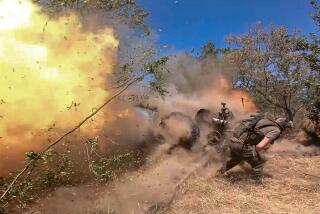Operation “Citadel”--Kursk and Orel: THE GREATEST TANK BATTLE OF THE SECOND WORLD WAR by Janusz Piekalkiewicz; translated by Michaela Nierhaus; (Presidio: $25; 288 pp., illustrated)
- Share via
The cataclysmic battles between the Germans and Soviets on the Eastern Front during World War II have only recently gained the attention in the United States they deserve. Indeed, the battles of this “Unknown War” involved many ferocious clashes between forces the size of which have not been seen before or since.
After initially attacking the Soviet Union in June, 1941, Hitler’s forces had been steadily pushed back by the Soviets since the ignominious defeat and surrender of Von Paulus’ Sixth Army at the gates of Stalingrad in January, 1943, and Von Manstein’s brilliant counteroffensive at Kharkov in March, 1943. Hitler, unwilling to face the reality that the tide of war was beginning to turn against him, hoped to regain the initiative by launching Operation “Citadel.” This was intended to cut off the Kursk salient and create a gap in the Soviet front, which could then be exploited. Kicking off on July 5, 1943, this operation eventually involved more than 2.2 million German and Soviet soldiers, 5,000 aircraft and 6,000 tanks. It also included the greatest tank battle of World War II.
This vicious battle of attrition is the topic of “Operation ‘Citadel,’ ” which has been translated from the original German version. The book is introduced in a unique and very helpful manner with an overview of all aspects of the terrain, climate, and geography of the Kursk-orel area and their impact upon military operations. This is followed by biographical sketches of the commanders of the opposing forces.
The four-month-long preparation phase is chronicled by daily excerpts from military reports of both armies, intelligence summaries, newspapers and radio broadcasts, interspersed with the observations of the leading participants, as is the entire book. The author adroitly analyzes all of the activities, relating them to the entire operation.
Janusz Piekalkiewicz provides an extremely thorough and incisive analysis of the build-up for this operation. He refutes the theory that the Soviets were kept informed of the German preparations and plans by the “Lucy” spy ring operating in Geneva, Switzerland. In fact, according to the author, much of “Lucy’s” information was erroneous.
By an exhaustive research of formerly classified primary documents in archives in London, Moscow, and Bonn, among others, the author has shown that the British Secret Service provided this information--known as Ultra--to Stalin. The British had broken the “absolutely undecipherable” code of the Germans and were able to decipher all their radio messages. This revelation of the author has resulted in a reassessment of the Soviet strategy for conducting an active defense and counteroffensive to grind the Nazi attack to a halt.
The Soviets turned the area of the Kursk salient into a heavily fortified and defended bastion. This masterfully camouflaged defensive trench system was without parallel on the Eastern Front.
The author has divided Operation “Citadel” into three phases. Phase 1 (July 4-11, 1943) corresponds with the German attack and greatest penetration of sectors of the Kursk salient. Phase 2 (July 12-15, 1943) included the commitment of Soviet strategic reserves in a counteroffensive that shifted the initiative to the Red Army. This attack centered around the town of Prokhorovka. On both sides, 1,200 tanks and self-propelled guns supported by an equal number of aircraft fought in this “greatest mobile battle in the history of war.” On July 13, 1943, Hitler conceded that “Citadel” had failed. He ordered the withdrawal of some of the all-important tank units to Italy, since the Anglo-American invasion of Sicily had occurred only three days earlier. Hitler ordered, July 15, 1943, that the offensive be terminated.
The Germans were forced to withdraw to their initial July 5, 1943, attack positions. A new Soviet offensive at Orel marked the beginning of Phase 3 (July 16-Aug. 5, 1943) of the operation. German troops withdrew from the city of Orel on Aug. 5, 1943.
The success of the German onslaught was contingent upon the element of surprise. This was obviously impossible in light of the accurate and timely intelligence Stalin received. The Red Army was prepared to meet the Wehrmacht. German Panther and Tiger tanks spearheaded the assault and engaged Soviet T-34s in a swirling maelstrom of fire and steel. Artillery fire was of a previously unknown intensity. Fighter planes savagely attacked each other trying to gain air supremacy. Air-ground cooperation was a significant feature of the German operations, which also used Henschels and Stukas with great effect in destroying Soviet tanks. Resolute German infantrymen vigorously assaulted the tenacious Soviet defenders. It was an operation in which men and machines were strained to the limits of endurance and performed unbelievable feats, and this enthralling book about it cannot be recommended too highly to those interested in military history.
More to Read
Sign up for our Book Club newsletter
Get the latest news, events and more from the Los Angeles Times Book Club, and help us get L.A. reading and talking.
You may occasionally receive promotional content from the Los Angeles Times.










